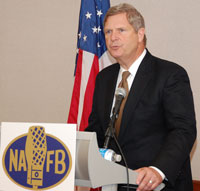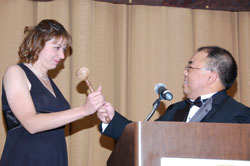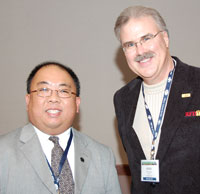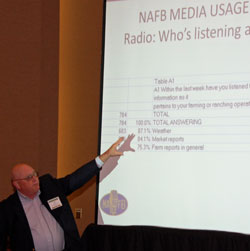 Agriculture Secretary Tom Vilsack was asked three times about some aspect of the proposed Grain Inspection, Packers and Stockyards Administration (GIPSA) rule during a press conference last week at the National Association of Farm Broadcasting meeting in Kansas City, and each time he said he could not comment specifically about the proposed rule during the comment period.
Agriculture Secretary Tom Vilsack was asked three times about some aspect of the proposed Grain Inspection, Packers and Stockyards Administration (GIPSA) rule during a press conference last week at the National Association of Farm Broadcasting meeting in Kansas City, and each time he said he could not comment specifically about the proposed rule during the comment period.
But, he did make some remarks related to the proposed rule. Ron Hays of Oklahoma asked if there was a plan for evaluating the large number of comments being made on the issue – over 16,000 so far. Vilsack said that has not been discussed yet. “I didn’t think it was appropriate to have that conversation until the comment period was concluded so we know what the universe is and we can do an evaluation of the nature of the comments,” he said. “There’s a difference between 16,000 unique comments and 16,000 comments of which a substantial number of them are basically form letters.”
In response to studies that have been released showing a significant negative economic impact if the rule is implemented, Vilsack again said he couldn’t comment, but expressed concern about the declining numbers of farmers and ranchers in the country. “In 1980, we had 660,000 pork producers. Today we have 71,000 – about a 90 percent reduction in pork producers. That same period we had 1.5 million cattle producers, today we have 950,00 – so we lost about a third. Ten years ago, we had 110,000 dairy producers – today we have about 60,000,” said Vilsack. “Is everybody satisfied with those trends?” With less than one percent of the population on the farm, Vilsack says if that trend continues, “Who are you all going to be broadcasting to?”
The secretary says USDA has made the studies required for proposing the rule and he doesn’t want to make specific comments about anything until after the comment period ends on November 22.
Listen to or download Vilsack’s GIPSA comments here: Vilsack GIPSA




 New NAFB president Lindsay Hill (ABN Radio) accepted the gavel from Greg Akagi (WIBW/Kansas Ag Net) during the Friday night president’s banquet to symbolize the beginning of a new slate of officers for the farm broadcasting organization, even though it will be the end of the year before it officially changes.
New NAFB president Lindsay Hill (ABN Radio) accepted the gavel from Greg Akagi (WIBW/Kansas Ag Net) during the Friday night president’s banquet to symbolize the beginning of a new slate of officers for the farm broadcasting organization, even though it will be the end of the year before it officially changes. The new vice president of NAFB is Mark Oppold of RFD TV. I had the chance to interview both Mark and outgoing president Greg right after the business meeting was held on Friday afternoon. Greg says he is looking forward to seeing his family again after three years on the road for NAFB. “I’m going to relax. I’m just imagining that my wife, when December 31 rolls around, will say ‘Happy New Year’ and hand me a 2-3 page list that may take me all of 2011 to accomplish!”
The new vice president of NAFB is Mark Oppold of RFD TV. I had the chance to interview both Mark and outgoing president Greg right after the business meeting was held on Friday afternoon. Greg says he is looking forward to seeing his family again after three years on the road for NAFB. “I’m going to relax. I’m just imagining that my wife, when December 31 rolls around, will say ‘Happy New Year’ and hand me a 2-3 page list that may take me all of 2011 to accomplish!” Two of the most coveted awards of the year for farm broadcasters were handed out during the luncheon on Friday.
Two of the most coveted awards of the year for farm broadcasters were handed out during the luncheon on Friday. Current Rep. Jerry Moran (R-KS), who is now Senator-Elect for that state, stopped by the NAFB meeting on his way out to the nation’s capitol on Friday.
Current Rep. Jerry Moran (R-KS), who is now Senator-Elect for that state, stopped by the NAFB meeting on his way out to the nation’s capitol on Friday.  The latest research on who is listening or watching what in farm broadcast media was presented Friday morning at the NAFB annual meeting by the great Teddy Haller.
The latest research on who is listening or watching what in farm broadcast media was presented Friday morning at the NAFB annual meeting by the great Teddy Haller.
 County music star Sammy Kershaw entertained the NAFB annual meeting Thursday night, bringing back an old tradition of live entertainment.
County music star Sammy Kershaw entertained the NAFB annual meeting Thursday night, bringing back an old tradition of live entertainment.